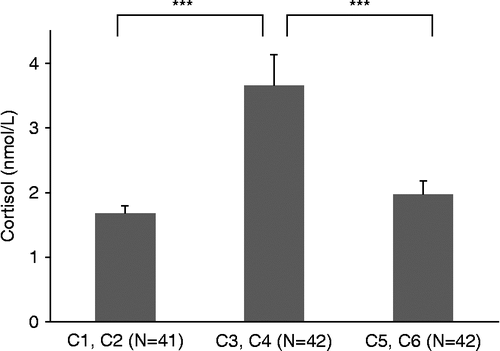Figures & data
Table I. Descriptive statistics of demographic characteristics and confounders (N = 42).
Table II. Correlations between the actual increase in salivary cortisol concentration (nmol/L) and possible confounders.
Figure 1. Salivary cortisol concentrations (mean ± SEM) over the CREST paradigm: baseline concentration (lowest of samples C1 and C2), stress concentration (highest of samples C3 and C4), and recovery concentration (lowest of samples C5 and C6) for the group as a whole. N = number of children/samples for each collection point. Paired samples t-tests showed a significant difference in cortisol concentrations between baseline and stress measurements, and a significant difference between stress and recovery measurements (***p < 0.001).

Figure 2. Top: detailed timeline of the CREST paradigm. Saliva sampling points for cortisol assessment are marked as C1, C2 (baseline), C3, C4 (stress reaction), C5, C6 (recovery). The thick bar indicates the stress phase (20 min: 15 min of performance stress plus 5 min of stress due to an anticipated evaluation). Bottom: salivary cortisol concentrations (mean ± SEM) over the CREST (gray box) for reactors, N = 25 children; mean peak increase in salivary cortisol concentration [mean increase from lowest baseline sample (C1/C2) to highest stress sample (C3/C4)] = 214%; p < 0.001, paired t-test; and non-reactors, N = 16 children; mean decrease in cortisol [mean change from lowest baseline sample (C1/C2) to highest stress sample (C3/C4)] = 7.8%; not significant, paired t-test.
![Figure 2. Top: detailed timeline of the CREST paradigm. Saliva sampling points for cortisol assessment are marked as C1, C2 (baseline), C3, C4 (stress reaction), C5, C6 (recovery). The thick bar indicates the stress phase (20 min: 15 min of performance stress plus 5 min of stress due to an anticipated evaluation). Bottom: salivary cortisol concentrations (mean ± SEM) over the CREST (gray box) for reactors, N = 25 children; mean peak increase in salivary cortisol concentration [mean increase from lowest baseline sample (C1/C2) to highest stress sample (C3/C4)] = 214%; p < 0.001, paired t-test; and non-reactors, N = 16 children; mean decrease in cortisol [mean change from lowest baseline sample (C1/C2) to highest stress sample (C3/C4)] = 7.8%; not significant, paired t-test.](/cms/asset/7dc0f5a1-a638-4e3c-a75b-dc68aaf615f0/ists_a_684112_f0002_b.gif)
